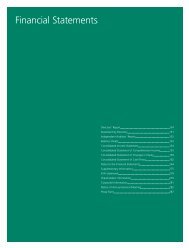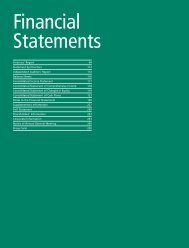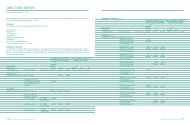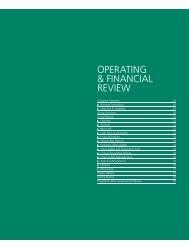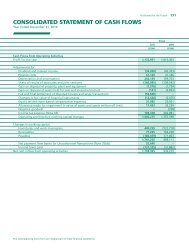FINANCIAL STATEMENTS (Full Version) - Sembcorp
FINANCIAL STATEMENTS (Full Version) - Sembcorp
FINANCIAL STATEMENTS (Full Version) - Sembcorp
Create successful ePaper yourself
Turn your PDF publications into a flip-book with our unique Google optimized e-Paper software.
Notes to the<br />
Financial Statements<br />
Year Ended December 31, 2008<br />
2. SUMMARY OF SIGNIFICANT ACCOUNTING POLICIES (cont’d)<br />
i. Hedging<br />
i. Fair Value Hedges<br />
Where a derivative financial instrument hedges the changes in fair value of a recognised asset or liability or an<br />
unrecognised firm commitment (or an identified portion of such asset, liability or firm commitment), any gain<br />
or loss on the hedging instrument is recognised in the income statement. The hedged item is also stated at fair<br />
value in respect of the risk being hedged, with any gain or loss recognised in the income statement.<br />
ii.<br />
Cash Flow Hedges<br />
Where a derivative financial instrument is designated as a hedge of the variability in cash flows of a recognised<br />
asset or liability, or a highly probable forecast transaction, the effective part of any gain or loss on the derivative<br />
financial instrument is recognised directly in equity. The ineffective part of any gain or loss is recognised<br />
immediately in the income statement. When the forecast transaction subsequently results in the recognition<br />
of a non-financial asset or non-financial liability, or the forecast transaction for a non-financial asset or nonfinancial<br />
liability becomes a firm commitment for which fair value hedge accounting is applied, the associated<br />
cumulative gain or loss is removed from equity and included in the initial cost or other carrying amount of the<br />
non-financial asset or liability. If a hedge of a forecast transaction subsequently results in the recognition of a<br />
financial asset or financial liability, the associated gains and losses that were recognised directly in equity are<br />
reclassified into the income statement in the same period or periods during which the asset acquired or liability<br />
assumed affects the income statement.<br />
When a hedging instrument expires or is sold, terminated or exercised, or the entity revokes designation of<br />
the hedge relationship but the hedged forecast transaction is still expected to occur, the cumulative gain or<br />
loss at that point remains in equity and is recognised in accordance with the above policy when the transaction<br />
occurs. If the hedged transaction is no longer expected to take place, the cumulative unrealised gain or loss<br />
recognised in equity is recognised immediately in the income statement.<br />
iii. Hedge of Monetary Assets and Liabilities<br />
Where a derivative financial instrument is used to hedge economically the foreign exchange exposure of a<br />
recognised monetary asset or liability, no hedge accounting is applied and any gain or loss on the hedging<br />
instrument is recognised in the income statement.<br />
iv. Hedge of Net Investment in a Foreign Operation<br />
The gain or loss on a financial instrument used to hedge a net investment in a foreign operation is recognised<br />
in the Company’s income statement. On consolidation, only the portion of the gain or loss on the hedging<br />
instrument that is determined to be an effective hedge is reclassified to equity. This amount is recognised in<br />
the consolidated income statement on disposal of the foreign operation.<br />
v. Separable Embedded Derivatives<br />
Changes in the fair value of separable embedded derivatives are recognised immediately in the income statement.<br />
2. SUMMARY OF SIGNIFICANT ACCOUNTING POLICIES (cont’d)<br />
j. Inventories<br />
i. Finished Goods and Components<br />
Inventories are stated at the lower of cost and net realisable value.<br />
ii.<br />
Cost is calculated using the weighted average cost formula and comprises all costs of purchase, costs of<br />
conversion and other costs incurred in bringing the inventories to their present location and condition. In the<br />
case of manufactured inventories and work-in-progress, cost includes an appropriate share of overheads based<br />
on normal operating capacity. Costs of inventories also include the transfer from equity, if any, of gains / losses<br />
on qualifying cash flow hedges relating to purchases of raw materials.<br />
Net realisable value is the estimated selling price in the ordinary course of business less the estimated costs of<br />
completion and the estimated costs necessary to make the sale.<br />
When inventories are sold, the carrying amount of those inventories is recognised as an expense in the period<br />
in which the related revenue is recognised.<br />
The amount of any allowance for write-down of inventories to net realisable value and all losses of inventories<br />
are recognised as an expense in the period the write-down or loss occurs. The amount of any reversal of any<br />
allowance for write-down of inventories, arising from an increase in net realisable value, is recognised as a<br />
reduction in the amount of inventories recognised as an expense in the period in which the reversal occurs.<br />
Long-term Contracts<br />
The accounting policy for recognition of contract revenue is set out in Note 2(v)(ii).<br />
Long-term contracts-in-progress at the balance sheet date are recorded in the balance sheet at cost plus<br />
attributable profit less recognised losses, net of progress claims and allowance for foreseeable losses, and are<br />
presented in the balance sheet as “Work-in-progress” (as an asset) or “Excess of progress claims over workin-progress”<br />
(as a liability), as applicable. Long-term contract costs include the cost of direct materials, direct<br />
labour and costs incurred in connection with the project. When it is probable that total contract costs will<br />
exceed total contract revenue, the expected loss is recognised as an expense immediately.<br />
Progress claims not yet paid by the customer are included in the balance sheet under “Trade receivables”.<br />
Amounts received before progress claims are included in the balance sheet, as a liability, as “Advance payments<br />
from customers”.<br />
iii. Properties Held for Sale<br />
Properties held for sale are stated at the lower of cost and net realisable value.<br />
Cost includes the cost of real estate purchased, construction cost, finance cost and other direct expenditure<br />
and related overheads incurred during construction. Net realisable value represents the estimated selling price<br />
less the anticipated cost of disposal.<br />
The carrying amounts are reviewed at each balance sheet date to assess whether they are recorded in excess of<br />
their recoverable amounts, and if carrying values exceed these recoverable amounts, the assets are written down.<br />
128 Delivering Essential Solutions <strong>Sembcorp</strong> Industries Annual Report 2008 129




